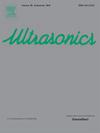Probing phased-array focused ultrasound transducers using realistic 3D in-silico trabecular skull models: a numerical study
IF 3.8
2区 物理与天体物理
Q1 ACOUSTICS
引用次数: 0
Abstract
Transcranial focused ultrasound (tFUS) is an emerging neuromodulation technology with transformative potential for brain disease therapies. This study explores how the trabecular structure of the human skull affects the performance of multi-element tFUS transducers. Numerical simulations were conducted using realistic 3D skull models with varying porosities (0 %, 50 %, and 60 %), comparing the pressure fields generated by two geometrically distinct 96-elements phased-array transducers (f-number = 0.8 −transducer 1- and f-number = 1.1 −transducer 2-).
Pressure distribution maps and −6dB isosurfaces were analyzed to quantify focal and scattered volumes, as well as focus shifts. Results demonstrate that porous skull models significantly impact the pressure field, introducing scattering and hotspots outside the target area, that are undetectable with non-porous models. Both transducers exhibit focus shifts along the propagation axis, with transducer 2 showing lower selectivity and nearly 450 % and 1000 % increased scattering compared to transducer 1 in the porous models.
These findings emphasize the necessity of incorporating such models in tFUS simulations to improve the accuracy of pressure predictions and device performance. Our results highlight the critical importance of accurately modelling skull porosity in tFUS simulations. Using simplified non-porous models can obscure scattering effects and lead to distorted predictions of transducer performance. This work also demonstrates how generating in-silico porous models with varying porosity allows for testing the reliability and robustness of a numerically designed transducer. It also provides valuable insights into optimizing transducer design ultimately improving target precision while mitigating unintended sonication, laying the groundwork for safer and more effective tFUS therapies.
探测相控阵聚焦超声换能器使用真实的三维硅骨小梁颅骨模型:数值研究
经颅聚焦超声(tFUS)是一种新兴的神经调节技术,具有改变脑部疾病治疗的潜力。本研究探讨了人类颅骨小梁结构如何影响多单元tFUS换能器的性能。采用不同孔隙率(0%、50%和60%)的真实三维颅骨模型进行了数值模拟,比较了两个几何上不同的96元相控阵换能器(f-number = 0.8−换能器1-和f-number = 1.1−换能器2-)产生的压力场。分析压力分布图和- 6dB等面,量化焦点和分散体积,以及焦点位移。结果表明,多孔颅骨模型会显著影响压力场,在目标区域外引入散射和热点,这是非多孔模型无法检测到的。两个换能器都表现出沿传播轴的焦点位移,在多孔模型中,与换能器1相比,换能器2的选择性更低,散射增加了近450%和1000%。这些发现强调了将这些模型纳入tFUS模拟的必要性,以提高压力预测的准确性和设备性能。我们的研究结果强调了在tFUS模拟中准确模拟颅骨孔隙度的重要性。使用简化的无孔模型会模糊散射效应,导致换能器性能的预测失真。这项工作还展示了如何生成具有不同孔隙度的硅多孔模型,从而可以测试数值设计传感器的可靠性和鲁棒性。它还为优化换能器设计提供了宝贵的见解,最终提高了目标精度,同时减少了意外的超声,为更安全、更有效的tFUS治疗奠定了基础。
本文章由计算机程序翻译,如有差异,请以英文原文为准。
求助全文
约1分钟内获得全文
求助全文
来源期刊

Ultrasonics
医学-核医学
CiteScore
7.60
自引率
19.00%
发文量
186
审稿时长
3.9 months
期刊介绍:
Ultrasonics is the only internationally established journal which covers the entire field of ultrasound research and technology and all its many applications. Ultrasonics contains a variety of sections to keep readers fully informed and up-to-date on the whole spectrum of research and development throughout the world. Ultrasonics publishes papers of exceptional quality and of relevance to both academia and industry. Manuscripts in which ultrasonics is a central issue and not simply an incidental tool or minor issue, are welcomed.
As well as top quality original research papers and review articles by world renowned experts, Ultrasonics also regularly features short communications, a calendar of forthcoming events and special issues dedicated to topical subjects.
 求助内容:
求助内容: 应助结果提醒方式:
应助结果提醒方式:


